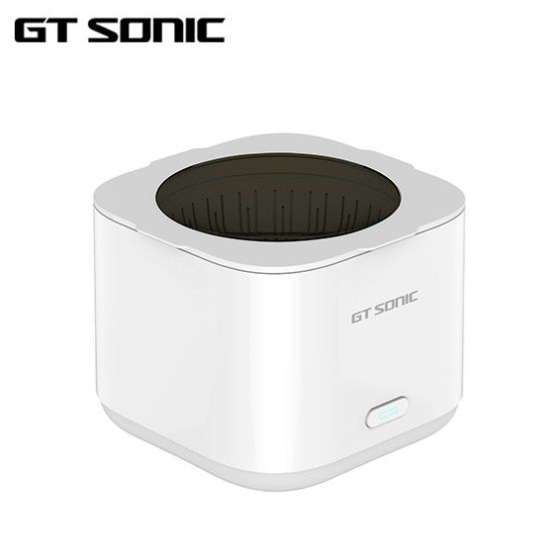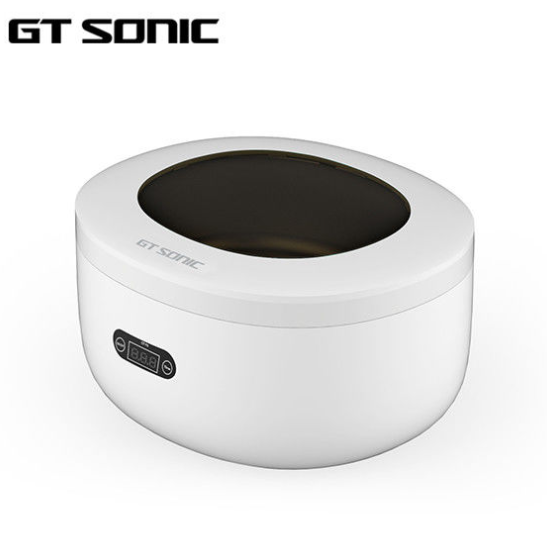Why Choose the GT-X3 Ultrasonic Dental Cleaner for Your Practice?
2025-11-12
Ultrasonic dental cleaning is a highly effective method for cleaning dental instruments using ultrasonic waves. This cleaning technology utilizes high-frequency sound waves.
The GT-X3 Ultrasonic Dental Cleaner is an ideal choice for dental practices looking to improve hygiene and efficiency. Utilizing high-frequency sound waves at 40 kHz, it effectively removes plaque, debris, and contaminants from dental instruments without harsh scrubbing. Its compact design, portable 180ml capacity, and durable SUS304 stainless steel chamber make it perfect for small to medium-sized practices.
What is ultrasonic dental cleaning?
-How does dental ultrasonic cleaner work?
-Ultrasonic teeth cleaning vs scaling
How to use ultrasonic cleaner for dental instruments?
-What is the proper way to place instruments in the ultrasonic cleaner?
-How long to run an ultrasonic cleaner for dental instruments?
-What is the best solution for ultrasonic cleaning: GT-X3 ultrasonic washer
-The 180ml small ultrasonic cleaner is more portable.
-The Importance of SUS304 Stainless Steel Material in ultrasonic cleaners
-10w ultrasonic cleaner 40khz ultrasonic cleaning
Best ultrasonic cleaner for dental instruments:Buying Guide(2025)
Suggested Dental Practice Ultrasonic Cleaning Solutions:Gt sonic ultrasonic cleaner
-GT-F6 Ultrasonic Automatic Denture Cleaner
-VGT-6250 65W Ultrasonic Instrument Cleaner
-VGT-1620QTD 100W Waterproof Medical Ultrasonic Cleaning Machine
What is Ultrasonic Dental Cleaning?

Ultrasonic dental cleaning is a highly effective method for cleaning dental instruments using ultrasonic waves. This cleaning technology utilizes high-frequency sound waves that produce microscopic bubbles within a cleaning solution. These bubbles implode, generating a powerful scrubbing action that effectively removes dirt, debris, and contaminants from dental tools. Ultrasonic cleaning is commonly used in dental practices to ensure thorough cleaning before sterilization.
How Does Dental Ultrasonic Cleaner Work?
An ultrasonic cleaner, like the GT-X3, works by emitting high-frequency sound waves, typically at 40 kHz. These sound waves create cavitation bubbles in the cleaning solution. When these bubbles collapse, they generate a microscopic but intense cleaning action that dislodges dirt, bacteria, plaque, and other residues from dental instruments. The result is a thorough, effective cleaning without the need for harsh scrubbing, which could potentially damage delicate instruments.
Ultrasonic Teeth Cleaning vs Scaling
While both ultrasonic teeth cleaning and scaling are used to remove plaque and tartar from teeth, there’s a significant difference in the method and application:
1.Ultrasonic Teeth Cleaning: This is performed by a dental hygienist or dentist using an ultrasonic scaler. The device uses ultrasonic waves to vibrate and break up the plaque, tartar, and bacteria on the tooth surface. This method is more efficient for removing stubborn deposits and is often less invasive and more comfortable for patients.
2.Scaling: Manual scaling is a more traditional method where the dentist or hygienist uses hand-held tools to physically scrape plaque and tartar from the teeth. While effective, it requires more physical effort and can sometimes be uncomfortable for the patient.
Ultrasonic cleaning, both for instruments and teeth, is gaining preference in dental practices due to its ability to clean more thoroughly and efficiently with less manual effort.
How to Use Ultrasonic Cleaner for Dental Instruments?

Using an ultrasonic cleaner like the GT-X3 for dental instruments is straightforward, but proper technique is essential to ensure the cleaning process is as effective as possible. Here’s how you can use it:
What is the Proper Way to Place Instruments in the Ultrasonic Cleaner?
When using the GT-X3 ultrasonic cleaner for dental instruments, the placement of instruments is crucial for effective cleaning. Follow these guidelines:
1.Do Not Overload: Ensure that the instruments do not touch each other or the sides of the tank. Overloading can prevent the ultrasonic waves from effectively reaching all areas of the instruments.
2.Positioning: Place the instruments flat in the basket to allow maximum exposure to the ultrasonic waves. Position them in a way that allows the bubbles to reach every surface, ensuring thorough cleaning.
3.Use a Basket or Tray: Using the provided basket or tray will help organize instruments and prevent them from directly touching the bottom of the tank, which could damage them.
How Long to Run an Ultrasonic Cleaner for Dental Instruments?
The cleaning time depends on the type of instruments and the level of contamination. However, a typical cleaning cycle for dental instruments is between 5-10 minutes. The GT-X3 ultrasonic cleaner, with its 40 kHz frequency, is ideal for providing effective and thorough cleaning in a short period. For heavily soiled instruments, you may want to extend the cleaning time slightly, but avoid running the cleaner for too long, as it may cause unnecessary wear on the instruments.
What is the Best Solution for Ultrasonic Cleaning: GT-X3 Ultrasonic Washer

The GT-X3 Ultrasonic Dental Cleaner is one of the best choices for dental practices looking for a reliable, efficient, and portable ultrasonic cleaner. Here’s why:
The 180ml Small Ultrasonic Cleaner is More Portable
One of the standout features of the GT-X3 is its compact and portable design. The 180ml capacity makes it ideal for small dental offices or mobile practices. You can easily move it between rooms or take it to different locations within the practice, providing flexibility and convenience. Despite its size, it offers excellent cleaning power, making it suitable for various dental instruments.
The Importance of SUS304 Stainless Steel Material in Ultrasonic Cleaners
The GT-X3 uses SUS304 stainless steel for its cleaning chamber, which is highly resistant to corrosion and rust. This is essential in a dental environment, where constant exposure to water, disinfectants, and cleaning agents is inevitable. SUS304 is durable, non-reactive, and resistant to staining, ensuring that the ultrasonic cleaner remains in top condition for longer periods, thus providing reliable performance over time.
10W Ultrasonic Cleaner, 40kHz Ultrasonic Cleaning
The GT-X3 operates at 40 kHz frequency, which is ideal for cleaning delicate dental instruments. The 10W power output ensures that it provides enough energy to effectively remove dirt, plaque, and other debris without damaging sensitive instruments. The 40 kHz frequency is widely regarded as the most efficient frequency for cleaning dental tools, striking a balance between power and precision.
Best Ultrasonic Cleaner for Dental Instruments: Buying Guide (2025)

When selecting an ultrasonic cleaner for dental instruments, several factors should be taken into consideration to ensure that you choose the best device for your practice:
1.Size and Capacity: Consider how many instruments you need to clean at once. Smaller units, like the GT-X3, are perfect for smaller practices or specific tools, while larger models may be necessary for busy clinics with high instrument turnover.
2.Frequency and Power: The frequency of the ultrasonic waves affects the cleaning efficiency. For dental instruments, 40 kHz is the most common and effective frequency. The power output (measured in watts) should also match the size and type of instruments you are cleaning.
3.Material Quality: Look for an ultrasonic cleaner made from high-quality materials, such as SUS304 stainless steel, to ensure durability and prevent rusting.
4.Ease of Use: Ensure that the ultrasonic cleaner has simple controls and clear instructions for easy operation.
5.Maintenance Requirements: Choose a model that is easy to clean and maintain, with replaceable parts that are easily accessible.
Suggested Dental Practice Ultrasonic Cleaning Solutions: GT Sonic Ultrasonic Cleaner

GT Sonic provides a variety of ultrasonic cleaners specifically designed for dental practices. Here are some popular models:
GT-F6 Ultrasonic Automatic Denture Cleaner
The GT-F6 is an automatic ultrasonic cleaner designed specifically for cleaning dentures. It provides a thorough cleaning while being gentle on delicate materials, making it perfect for dental clinics that regularly handle prosthetics.
VGT-6250 65W Ultrasonic Instrument Cleaner
The VGT-6250 is a powerful ultrasonic cleaner with a 65W motor that’s ideal for larger dental instruments. Its higher power output ensures faster and more efficient cleaning, which is essential for busy dental practices with high volumes of instruments.
VGT-1620QTD 100W Waterproof Medical Ultrasonic Cleaning Machine
For practices that need a more heavy-duty solution, the VGT-1620QTD offers 100W of ultrasonic power. It’s designed for cleaning medical instruments and is waterproof, making it durable and easy to maintain in a high-use environment.
Conclusion
Choosing the right ultrasonic cleaner for your dental practice is crucial for maintaining high standards of hygiene, improving workflow efficiency, and prolonging the lifespan of your instruments. The GT-X3 Ultrasonic Dental Cleaner stands out as an excellent choice for small to medium-sized dental practices due to its portability, efficient cleaning power, and durable SUS304 stainless steel construction. When combined with the best ultrasonic cleaning solutions, the GT-X3 offers an effective and reliable cleaning solution for all your dental instruments. Consider investing in quality ultrasonic cleaning equipment to enhance your practice's productivity and patient safety.
Recommended reading
1.How to clean your mouth guard: Ultrasonic denture cleaner VS. Denture cleaning table
2.Top 5 Best Ultrasonic Cleaners for Dental Instruments: Effective Cleaning Solutions
3.The Ultimate Guide to the Best Ultrasonic Retainer Cleaner (2025)










